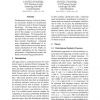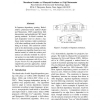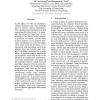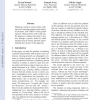COLING
2008
14 years 1 months ago
2008
This paper describes an incremental approach to parsing transcribed spontaneous speech containing disfluencies with a Hierarchical Hidden Markov Model (HHMM). This model makes use...
COLING
2008
14 years 1 months ago
2008
Our goal is to use natural language processing to identify deceptive and nondeceptive passages in transcribed narratives. We begin by motivating an analysis of language-based dece...
COLING
2008
14 years 1 months ago
2008
Distributional measures of lexical similarity and kernel methods for classification are well-known tools in Natural Language Processing. We bring these two methods together by int...
COLING
2008
14 years 1 months ago
2008
In Japanese dependency parsing, Kudo's relative preference-based method (Kudo and Matsumoto, 2005) outperforms both deterministic and probabilistic CKY-based parsing methods....
COLING
2008
14 years 1 months ago
2008
State-of-the-art statistical parsing models applied to free word-order languages tend to underperform compared to, e.g., parsing English. Constituency-based models often fail to c...
COLING
2008
14 years 1 months ago
2008
In this paper, we work on extending a Chinese thesaurus with words distinctly used in various Chinese communities. The acquisition and classification of such region-specific lexic...
COLING
2008
14 years 1 months ago
2008
This paper studies sentiment analysis from the user-generated content on the Web. In particular, it focuses on mining opinions from comparative sentences, i.e., to determine which...
COLING
2008
14 years 1 months ago
2008
This paper presents a method of retrieving bilingual collocations of a verb and its objective noun from cross-lingual documents with similar contents. Relevant documents are obtai...
COLING
2008
14 years 1 months ago
2008
In this paper we present a study on the interpretation of weekday names in texts. Our algorithm for assigning a date to a weekday name achieves 95.91% accuracy on a test data set ...
COLING
2008
14 years 1 months ago
2008
Matching coreferent named entities without prior knowledge requires good similarity measures. Soft-TFIDF is a fine-grained measure which performs well in this task. We propose to ...




